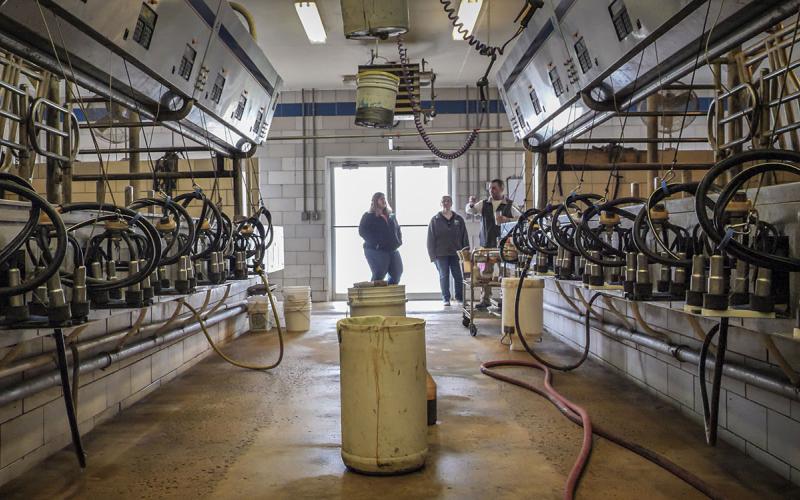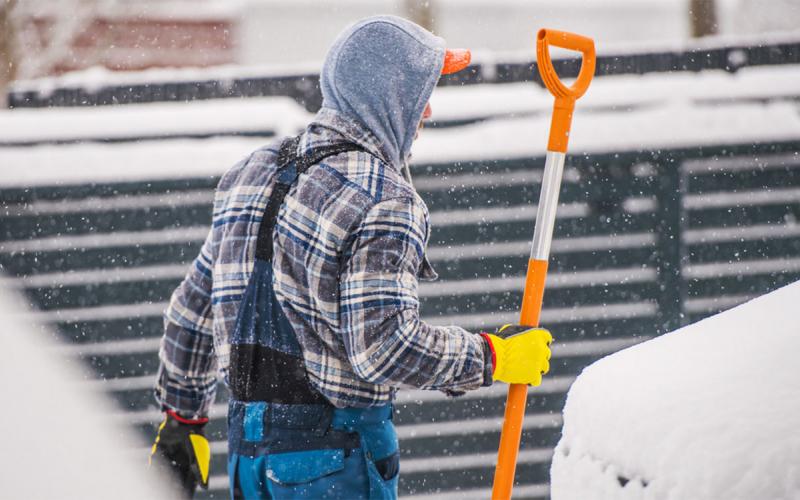
Written collaboratively by Maristela Rovai, Assistant Professor and SDSU Extension Dairy Specialist, and Luciana da Costa, Assistant Professor and Ohio State University Extension Veterinarian - Dairy.
Fall is upon us now, but sooner than we expect, winter will be approaching at any time during our work journeys, and we must be prepared as we head into the colder season.
Even though cows are housed in many parts of the country, cold weather may play an important factor in udder health and milk quality. During wintertime, it's crucial to create a good environment, and that requires a strategy in place for both livestock and people.
The key for achieving quality milk anytime during the year includes adopting proper milking procedures and care with udder and teats. The milking procedures include teat pre-dipping, foremilk stripping, dry-off teats and post-dipping. The teat dipping is an important part of the milking procedure and is included in a preventive mastitis plan. Mastitis continues to be the most-common disease in dairy cattle and the costliest to the dairy industry worldwide.
Udder teats are more prone to chapping (means cracked, rough and sore) in the winter with rash temperatures and dry-cold air, making the teat more susceptible to bacterial infections. Special care and precautions should be taken during the winter season to avoid chapped and frozen teats (frostbite) after cows are milked. Together, these factors may predispose teats to poor teat skin conditions and increase the risk of new intramammary infections if not taken seriously. Skin damage heals better when the wound is kept moist, and it is important not to use agents (e.g., iodine in those cases) that could dry it even more, or even inhibit the healing process. Complete healing of a frostbite injury can take more than a month (45 to 60 days), and milking will usually cause re-injury to the tissue and pain to the affected cows. Thus, to avoid possible teat damages, we should consider the following factors.
Things to Consider
Weather
During the winter months, one of the ways that forecasters alert the public is to inform the actual temperature and the wind-chill temperature (WCT). WCT is how people and animals feel when they are outside, and its intensity will be related to how strong the wind is blowing (National Weather Service).
Some researchers have shown that "wind-chill" has a more important impact than actual ambient temperature. To prevent frozen teats and consequently teat damage, we should pay attention to the National Weather Service Wind Chill Chart and know when frostbite might occur, as explained in Table 1.
| Wind-Chill Temperature | Probability of Frozen Teats |
|---|---|
| Above zero | Unlikely |
| 0 to -25 degrees Fahrenheit | Possibility |
| Below -25 degrees Fahrenheit | Could happen in less than one minute, especially if wet. |
Housing Area
- Temperature: Ensure a comfortable temperature inside the barns and avoid possible draft areas (i.e., damaged sidewalls, door seals). Note: A dairy cow's average body temperature is 101.5 degrees Fahrenheit (38.6 Celsius). Cows will feel comfortable in an air temperature environment between 25 to 65 degrees Fahrenheit (-3.8 y 18.3 Celsius).
- Bedding basics: Bedding should be kept dry and clean, free of manure and supplied daily with dry, clean bedding. While bacteria grow best in high temperatures and humidity, keep in mind that stall surfaces are only a few degrees lower than body temperature when cows are lying down, which is warm enough for bacteria to multiply.
- Windows and curtains: Malfunctioning curtains should be taken care of. Blocking the wind from loading areas and returning alleys outside the parlor will reduce wind-chill temperatures. This will help prevent chapping and frostbite.
Animals’ Predispositions
- Fresh cows may need special care due to udder edema, poor teat circulation and chapping. Their frequent monitoring would be key in preventing winter udder damage.
- Calves are more sensitive to cold than adult cows. Thus, to help the calves stay healthy and grow in the cold, they should stay warm. More details can be found in the "Providing Winter Care for Calves" resource available on the Ohio State University Extension Dairy Resources website.

Milking Procedures
- Pre-check of the teat skin conditions and teat end at the time of teat fore-stripping.
- Post-dipping products: Selecting a good teat dip is fundamental to keeping the skin healthy and preventing winter chapping. Emollients are known as conditioners or lotions, and they are water-based. These products are crucial to protect and soften the skin in cold weather. The ideal would be to use skin conditioners, like glycerin and lanolin, that leave less water but more glycerin than any other teat disinfectant. Note: You may frequently hear the word "ointment" to use on teats. This oil-based preparation usually contains medicine for applying to the teat skin when sore or damaged.
- Check how wet the teat is after using the post-dipping (Figure 1). If it is too wet, and you may experience severe wind-chill, allow teats time to dry before releasing cows, or dry the excess of the post dipping used with a clean towel before leaving the parlor, or only dip the teat end.
- Other tips include warming the dip product in a bucket of hot water before applying it to the teat. It is more comfortable for cows and reduces drying time.
- Manufacturing instructions: Following a product's label and instructions for use is essential to ensure effectiveness. Under severe cold or wind conditions, post-milking teat dipping with improperly formulated teat dips may facilitate teat chapping, resulting in increased colonization by the staphylococci usually associated with teat skin.
Please note that it's important to choose products that keep the teat skin healthy and protected during low temperatures, since it's not recommended to skip teat dipping during cold days. If teats are chapped, you should ask your supervisor and the veterinarian for help.
Employees

Remember to keep a warm environment in the parlor and avoid spilled water or milk on the parlor floor or stairs causing accidents if frozen.
More information on how to protect yourself during winter can be found in our article, Colder Weather Tips for Midwestern Dairy Farm Employees, available in English and Spanish.
Take-Home Message
- When do we need to start being worried about winter? Before it arrives so pay attention to lower temperatures and wind-chill. Check the weather at the National Weather Service website and customize your city and region.
- Is there a need to change the milking procedures during winter? No, but we need to adapt the miking procedures either using winter-specific products or checking the teat condition more frequently.
- Paying attention to details can minimize the impact of cold weather on cows allowing them to produce high-quality milk throughout the winter.
Let us know if you need a specific protocol or guidance for sharing with your employees and colleagues. We will be glad to help! You may contact Maristela Rovai or Luciana da Costa for more information.

